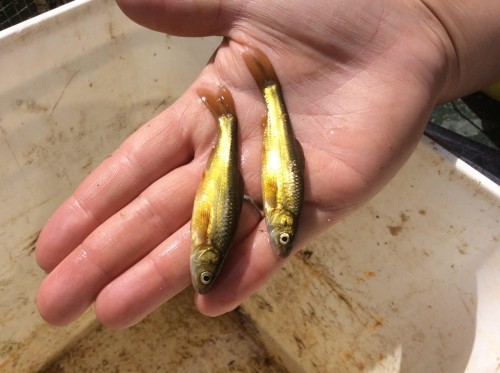Hybognathus hankinsoni
Identification Tips:
• Typically less than 75 mm in length
• Snout slightly overhangs the lower jaw.
• Dorsal fin originates in front of the pelvic fins.
• Scales are large; 37-40 along the lateral line.
• Lacks barbels at corners of mouth.
• Grey-brown in colour except when spawning
• Entire body turns brassy colour during spawning period.
• Sometimes confused with female Fathead Minnow
• In Fathead Minnow front ray of dorsal fin is thickened, not closely bound to second ray, and short (about half length of second ray).
• In Brassy minnow front dorsal ray is may be full length or shortened, slender, and closely aligned with 2nd ray
Conservation Status:
| British Columbia | Canada | Natureserve | |
| COSEWIC | Species at Risk Act | ||
| Blue List | Special Concern | None | G5, S2S3 |
Information Source: BC Conservation Data Centre: http://a100.gov.bc.ca/pub/eswp/
Life History:
• Feed on algae, zooplankton, and aquatic insects
• Predators may include introduced and native predatory species of fish and fish-eating birds.
• Mature in 2nd year.
• Extremely tolerant of low oxygen and high water temperature (to 35 C)
• Tolerate brackish water.
Habitat:
• Adults creeks, ditches, sloughs and wetlands, typically over mud bottoms and among dense vegetation.
• Spawn in late spring, usually over sand or gravel
Range:
British Columbia
• Abundant in the lower Fraser Valley and in the Prince George area, but very rare between.
• Also found in Peace River drainage
Global
• New York, south to Kansas and Missouri and west to Colorado, Wyoming, and Montana and north to southern Canada from Quebec to British Columbia.
• British Columbia and Alberta populations are discontinuous and include more northern areas.
––––––
Primary Information Source:
McPhail, J.D. 2007. The Freshwater Fishes of British Columbia. University of Alberta Press. Edmonton, Alberta.

